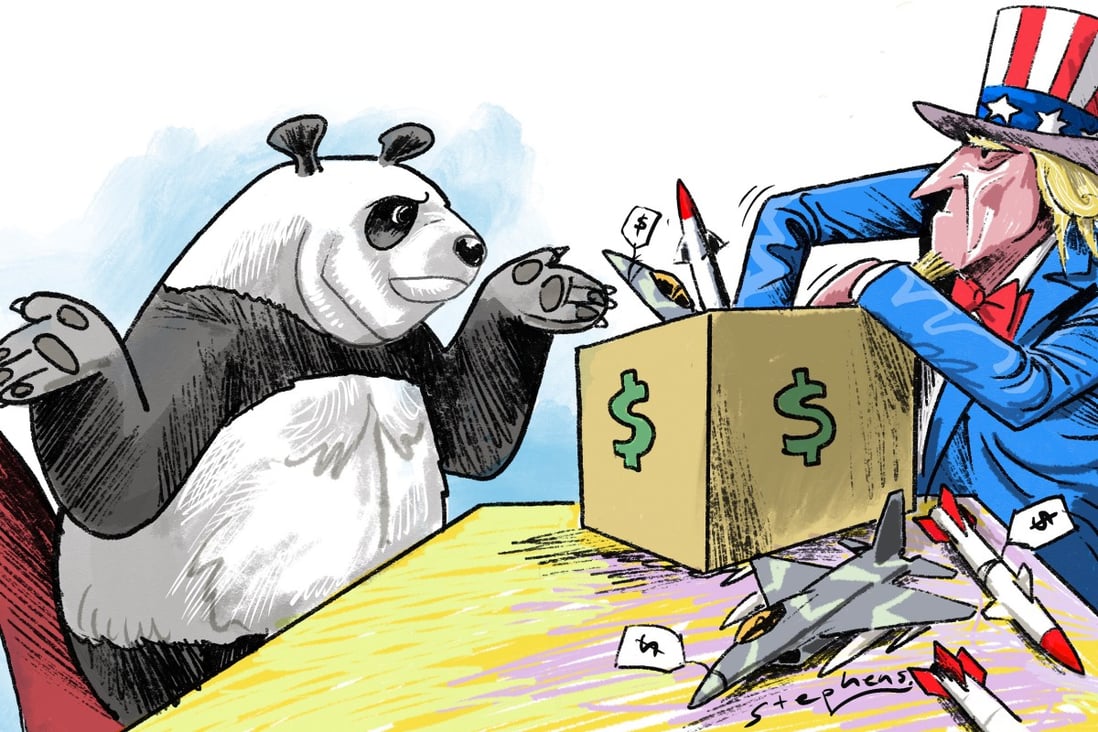In response to provocative actions by Taiwanese pro-independence and foreign forces, three strategies have emerged
Beijing is demonstrating its own conventional and cyber warfare capabilities, moving to engage in dialogue with regional US allies, and utilising economic statecraft
Opinion
Riaz Khokhar
Riaz Khokhar
SCMP
12 Jun, 2023

Illustration: Craig Stephens
It is no surprise that Chinese Defence Minister Li Shangfu did not meet his US counterpart Lloyd Austin at this month’s Shangri-La Dialogue in Singapore. For one thing, Beijing has repeatedly cautioned Washington against arms sales to Taiwan, which it views as support for pro-independence forces.
The 1982 US-China communique stated that arms sales to Taiwan would not be a long-term policy and signalled a phased reduction. However, Washington continues to justify these sales under the Taiwan Relations Act and Six Assurances.
Even as past US administrations sold arms to Taiwan, they prioritised a peaceful resolution to tension across the Taiwan Strait. But, in recent years, deliveries of offensive arms, regular warship transits through the Taiwan Strait and the treatment of Taiwan as a “critical node” in the Indo-Pacific have suggested that Washington may now be opposed even to peaceful cross-strait unification.
In the 1982 communique, the United States pledged to gradually decrease arms sales to Taiwan until a “final resolution”. Moreover, the Taiwan Relations Act obliges the US to provide Taiwan with the necessary arms for defence only. However, the Trump and Biden administrations have deviated from this commitment by supplying weapons in excess of the defence requirement.
During Donald Trump’s time in office, the arms sold included 66 F-16V fighter jets, 135 AGM-84H/K air-to-ground missiles and 100 Harpoon Coastal Defence Systems. The Joe Biden administration has continued in this vein, approving the sale of weapons such as 100 AGM-88B high-speed anti-radiation missiles, to be mounted on F-16 jets.
Additionally, the US routinely sends warships to the Taiwan Strait and reconnaissance aircraft to disputed areas of the South China Sea. In response, China’s navy deploys its warships and aircraft for surveillance and readiness.
Around the time of the Shangri-La Dialogue, close encounters between Chinese and US aircraft and warships were reported, raising the possibility that miscalculation or human error could lead to conflict between these military powers.
In this context, Washington circles often highlight mainland China’s growing military capabilities as a reason to prepare Taiwan for various contingencies, including asymmetric warfare. The US is bound by the Taiwan Relations Act to “resist” any force or coercion that jeopardises Taiwan’s security, or social and economic system. It has been rallying its Indo-Pacific allies against Beijing’s possible military coercion of Taiwan.
Ironically, from Beijing’s perspective, Washington’s assertive diplomacy and military posture may be the very factors that, under China’s 2005 Anti-Secession Law, contribute to Taiwan’s separation, impede peaceful unification efforts and force Beijing to consider employing “non-peaceful means”.
As it is, the Taiwanese are more negative towards Beijing than Washington, and Taipei is not just developing asymmetric warfare capabilities but also extending mandatory military service for men from four to 12 months.
In a recent think piece, the Stimson Center’s Yun Sun suggested that Beijing would not be able to force a shift in public opinion in Taiwan. But, in her view, nor would it attempt a direct takeover of Taiwan.
Given these circumstances, she said, Beijing’s best way forward is to eliminate Taiwan’s options by curtailing foreign interference in the Taiwan Strait and external support for the island.
To counter Taiwanese pro-independence and foreign forces, three Chinese strategies have emerged: demonstrating conventional and cyber warfare capabilities to deter the US; moving to engage in dialogue with regional US allies; and, utilising economic statecraft.
China recently showcased its military prowess by conducting simulated hypersonic strikes against a US aircraft carrier fleet. This highlighted the vulnerability of the US carrier group once regarded as unsinkable by conventional weapons.
Furthermore, cyberattacks allegedly originating from China were found this year to have targeted telecommunication systems in Guam and the US, raising concerns about future destructive attacks. In a crisis, Beijing’s top priority would be disrupting communication systems and the US Transportation Command that moves American military assets around.
A review of the 2018 US National Defence Strategy warned that the US could face a “decisive military defeat” by China, given its advanced capabilities and the logistical challenges confronting the US in the Indo-Pacific.
The US relies on its Indo-Pacific allies in its strategy of integrated deterrence against China. In response, Beijing is expected to move to engage in military dialogue with each of these allies, including Japan, South Korea and the Philippines.
While these countries adhere to the one-China policy, they are against a forceful change to the status quo in the Taiwan Strait. Beijing’s white paper on Taiwan seems to be for the benefit of these countries. It expresses Beijing’s sincere wish for peaceful reunification, with the use of force only as a last resort.
Despite aligning their broader strategies with the US, American allies such as Japan, South Korea, Australia and the Philippines stress the importance of China in regional peace and stability. They also advocate for dialogue to ease tensions between the US and China, and to stabilise their own relations with Beijing.
Behind the scenes, China and the US are engaged in dialogue
7 Jun 2023

12 Jun, 2023

Illustration: Craig Stephens
It is no surprise that Chinese Defence Minister Li Shangfu did not meet his US counterpart Lloyd Austin at this month’s Shangri-La Dialogue in Singapore. For one thing, Beijing has repeatedly cautioned Washington against arms sales to Taiwan, which it views as support for pro-independence forces.
The 1982 US-China communique stated that arms sales to Taiwan would not be a long-term policy and signalled a phased reduction. However, Washington continues to justify these sales under the Taiwan Relations Act and Six Assurances.
Even as past US administrations sold arms to Taiwan, they prioritised a peaceful resolution to tension across the Taiwan Strait. But, in recent years, deliveries of offensive arms, regular warship transits through the Taiwan Strait and the treatment of Taiwan as a “critical node” in the Indo-Pacific have suggested that Washington may now be opposed even to peaceful cross-strait unification.
In the 1982 communique, the United States pledged to gradually decrease arms sales to Taiwan until a “final resolution”. Moreover, the Taiwan Relations Act obliges the US to provide Taiwan with the necessary arms for defence only. However, the Trump and Biden administrations have deviated from this commitment by supplying weapons in excess of the defence requirement.
During Donald Trump’s time in office, the arms sold included 66 F-16V fighter jets, 135 AGM-84H/K air-to-ground missiles and 100 Harpoon Coastal Defence Systems. The Joe Biden administration has continued in this vein, approving the sale of weapons such as 100 AGM-88B high-speed anti-radiation missiles, to be mounted on F-16 jets.
Additionally, the US routinely sends warships to the Taiwan Strait and reconnaissance aircraft to disputed areas of the South China Sea. In response, China’s navy deploys its warships and aircraft for surveillance and readiness.
Around the time of the Shangri-La Dialogue, close encounters between Chinese and US aircraft and warships were reported, raising the possibility that miscalculation or human error could lead to conflict between these military powers.
In this context, Washington circles often highlight mainland China’s growing military capabilities as a reason to prepare Taiwan for various contingencies, including asymmetric warfare. The US is bound by the Taiwan Relations Act to “resist” any force or coercion that jeopardises Taiwan’s security, or social and economic system. It has been rallying its Indo-Pacific allies against Beijing’s possible military coercion of Taiwan.
Ironically, from Beijing’s perspective, Washington’s assertive diplomacy and military posture may be the very factors that, under China’s 2005 Anti-Secession Law, contribute to Taiwan’s separation, impede peaceful unification efforts and force Beijing to consider employing “non-peaceful means”.
As it is, the Taiwanese are more negative towards Beijing than Washington, and Taipei is not just developing asymmetric warfare capabilities but also extending mandatory military service for men from four to 12 months.
In a recent think piece, the Stimson Center’s Yun Sun suggested that Beijing would not be able to force a shift in public opinion in Taiwan. But, in her view, nor would it attempt a direct takeover of Taiwan.
Given these circumstances, she said, Beijing’s best way forward is to eliminate Taiwan’s options by curtailing foreign interference in the Taiwan Strait and external support for the island.
To counter Taiwanese pro-independence and foreign forces, three Chinese strategies have emerged: demonstrating conventional and cyber warfare capabilities to deter the US; moving to engage in dialogue with regional US allies; and, utilising economic statecraft.
China recently showcased its military prowess by conducting simulated hypersonic strikes against a US aircraft carrier fleet. This highlighted the vulnerability of the US carrier group once regarded as unsinkable by conventional weapons.
Furthermore, cyberattacks allegedly originating from China were found this year to have targeted telecommunication systems in Guam and the US, raising concerns about future destructive attacks. In a crisis, Beijing’s top priority would be disrupting communication systems and the US Transportation Command that moves American military assets around.
A review of the 2018 US National Defence Strategy warned that the US could face a “decisive military defeat” by China, given its advanced capabilities and the logistical challenges confronting the US in the Indo-Pacific.
The US relies on its Indo-Pacific allies in its strategy of integrated deterrence against China. In response, Beijing is expected to move to engage in military dialogue with each of these allies, including Japan, South Korea and the Philippines.
While these countries adhere to the one-China policy, they are against a forceful change to the status quo in the Taiwan Strait. Beijing’s white paper on Taiwan seems to be for the benefit of these countries. It expresses Beijing’s sincere wish for peaceful reunification, with the use of force only as a last resort.
Despite aligning their broader strategies with the US, American allies such as Japan, South Korea, Australia and the Philippines stress the importance of China in regional peace and stability. They also advocate for dialogue to ease tensions between the US and China, and to stabilise their own relations with Beijing.
Behind the scenes, China and the US are engaged in dialogue
7 Jun 2023

For example, China and Japan recently established a military hotline to prevent misunderstandings, given their security concerns in the East China Sea. The two countries are also resuming military exchanges in July, after four years.
The foreign policy positioning of these US allies suggests a low likelihood of direct military confrontation with mainland China over Taiwan.
Meanwhile, Beijing continues to limit Taiwan’s international presence. Honduras recently switched diplomatic recognition from Taipei to Beijing, the ninth country to do so since 2016. This reduction in Taiwan’s diplomatic allies, to 13, may impact the island both domestically and internationally.

Riaz Khokhar is a research analyst on geopolitics and security of the Indo-Pacific region and a former Asia studies visiting fellow at East-West Center in Washington
No comments:
Post a Comment